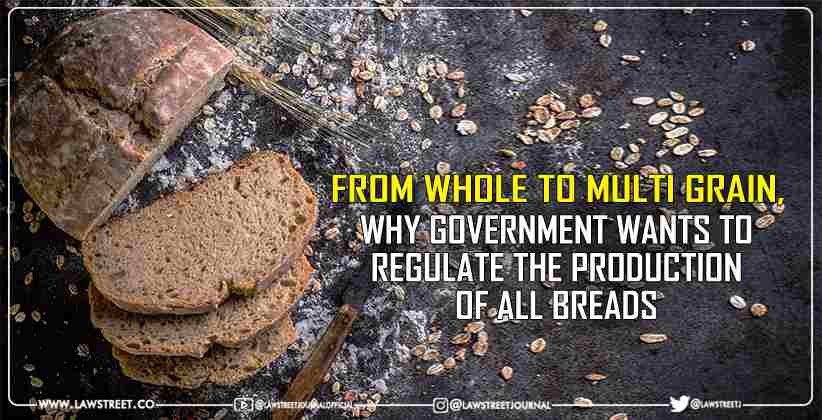The humble everyday bread has undergone a transformation. What entire generations had only known in its pristine white form is now available in a dizzying array of colours and textures. Whole wheat, multi grain, garlic, honey, brown, and many other varieties of the breakfast staple can now be found in any grocer's or supermarket. However, with increased variety comes increased confusion, which is why Indian authorities are considering minimum standards for all breads.
The Food Safety and Standards Authority of India (FSSAI), India's central watchdog, has shared draught regulations with the Union Ministry of Health and Family Welfare for regulating the quality of specialty breads, which are breads that have been enhanced for nutrition or taste.
The draught, obtained by News18.com, establishes minimum standards for whole wheat, brown, white, multi grain, and 14 specialty breads such as garlic, egg, oatmeal, milk, and cheese breads. The goal of establishing standards for these breads is to ensure that customers know what to expect when they purchase a specialty bread.
According to the proposed guidelines, there should be a minimum quantifiable level at which a "specialty ingredient" can be used. Further, it must be present in the aforementioned specialty bread if a prefix is added to the term bread' on the label, the specialty ingredient must be present.
What makes such standards necessary?
FSSAI mentioned the "rising need for food safety in the sector" and "trends in baking... towards lighter, healthier products, and those containing allergen-free, organic, and whole-grain ingredients" in its 2017 guidance document for bakery and bakery products. However, no standards for the production of specialty breads have been developed thus far.
Given changing lifestyles and rising consumption standards, inclusions and fortification are becoming increasingly popular.
FSSAI reported that "consumption of baked goods continues to rise."
The addition of inclusions to baked products necessitates changes to the original product formula, resulting in the creation of a new product from an existing one. "Such changes can be difficult for bakers because changes in formulation may necessitate changes in equipment, processes, and ingredient costs," it said.
Despite the fact that whole and alternative grains and grain products continue to drive new product development the FSSAI stated that "lack of technology and up gradation in manufacturing and packaging has been a factor affecting industry growth." The new specialty bread standards would thus aim to provide a yardstick for evaluating these products.
The vast majority of these products sold by confectionery behemoths adhere to uniformity. Local products, on the other hand, do not adhere to any standards. Audits and random checks will be ineffective unless the sector is regulated," an official said in a statement.
Are there any Regulations for Bread at present?
FSSAI issued the Food Safety and Standards (Food Products Standards and Food Additives) First Amendment Regulations, 2021 earlier this year, which updated the definitions of bakery products such as biscuits and breads.
According to the document, "Bread and bread type products such as rusks" refer to baked goods made from atta (whole wheat flour) and/or maida (refined wheat flour), water, salt, yeast or other fermentive medium or leavening medium. It includes various breads, rusks, and other baked goods. While it also mentions a list of ingredients such as honey, egg, and seasoning that can be added to breads, it does not specify the proportion at which they must be included for the product to be labelled as "specialty."
According to the FSSAI's 2017 bakery product guidelines, "baked goods using flours made from buckwheat, quinoa, millet, amaranth, flax, corn, rice, sorghum, wild rice, and other non-wheat grains remain a popular trend in baking" due to "demand for products that are free from gluten and other allergens."
These flours "offer tastes and textures that are uniquely different from wheat flours," according to FSSAI, and the trend is now toward "more types of artisan and handcrafted breads." As a result, regulations governing such breads appear to be a much-needed requirement.
How big is the Bakery Industry in India?
According to FSSAI, the bakery sector is the largest segment of the food processing sector in India, with over 2,000 organised or semi-organized bakeries producing around 1.3 million tonnes of bakery products and 1 million unorganized small-scale bakeries producing 1.7 million tonnes. According to the report, bread and biscuits are the "most popular bakery items," accounting for 80% of the total market.
What are the proposed minimum mix standards?
Whole wheat breads, according to the FSSAI standards, would be those with whole wheat flour as the specialty ingredient. It should account for at least 75% of the flour used in the product, while multi grain breads should contain at least 20% grains other than wheat.
Among other things, standard oatmeal bread must contain at least 15% of the specialty ingredient, while garlic bread must contain at least 2% garlic. Brown bread must contain at least 50% whole grain flour.
Similarly, honey bread must contain at least 5% honey, and cheese bread must contain at least 10% cheese. For varieties such as fruit, rye, raisin, and protein-enriched breads, mandatory thersholds have been established.
What is it like in other countries?
Elzbieta Gorynska-Goldmann of the Poznan University of Life Sciences in Poland writes in a 2010 paper on the 'Standardization Of The Bakery Goods' that setting production values for bread dates back to the beginnings of recorded history and can be "found in the Code of Hammurabi, the Bible, or the Koran."
"In the Bible, one may find notes about distinguishing unleavened bread from ordinary bread, done on leavening," she says, but adds that in the 'Codex Alimentarius' a collection of internationally recognized standards, guidelines, and so on published by the UN agency Food and Agriculture Organization (FAO) "no guidelines for bread classification have been found." That would be due to "not only technological differences, but also cultural differences," she claims.
Singapore, for example, states that wholegrain breads "shall be bread made from wholemeal flour or a mixture of wholemeal flour and other flours... [and] contain not less than 0.6 percent fibre calculated on the dry matter of bread." Furthermore, such bread "shall not contain any molasses or caramel coloring."
Similarly, fruit bread "shall contain raisins, currants, sultanas, or dried fruit in an amount not less than 10 kg... to every 100 kg of flour or wholemeal flour...Rye bread may not contain more than 70% flour, while milk bread must contain not less than 4% nonfat milk solids on a moisture-free basis."






